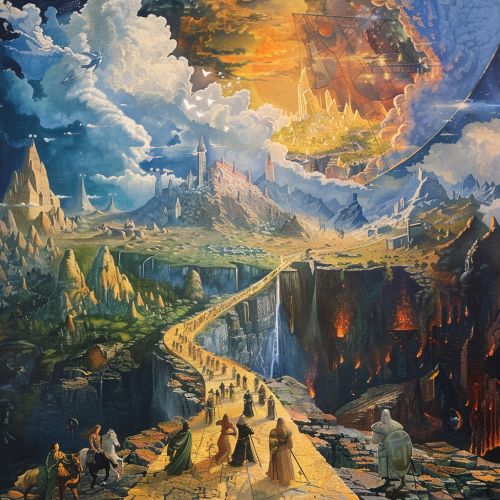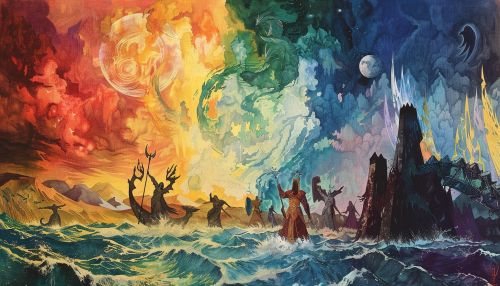Ainulindalë
Introduction
The Ainulindalë is the creation myth of the fictional universe in J.R.R. Tolkien's legendarium, primarily detailed in The Silmarillion. It describes the creation of the world, Eä, through the music of the Ainur, powerful spiritual beings created by Eru Ilúvatar, the supreme deity of Tolkien's universe. The Ainulindalë sets the stage for the complex mythological and cosmological framework that underpins the narratives of The Silmarillion, The Hobbit, and The Lord of the Rings.
The Ainur and Eru Ilúvatar
The Ainur, also known as the Holy Ones, are the first beings created by Eru Ilúvatar. They are akin to angels or demi-gods, each embodying different aspects of Ilúvatar's thought. The Ainur are divided into two groups: the Valar, who descend into the world to shape and govern it, and the Maiar, who assist the Valar in their tasks.
Eru Ilúvatar is the singular omnipotent deity in Tolkien's legendarium. He is the creator of the Ainur and the universe itself. Ilúvatar's role is primarily that of a creator and a prime mover, setting the initial conditions and allowing the Ainur to shape the world according to his grand design.
The Music of the Ainur
The central event of the Ainulindalë is the Music of the Ainur, a divine symphony conducted by Ilúvatar. Each Ainu contributes to the music according to their own nature and understanding. This music is a metaphor for the creation of the universe, with each theme representing different aspects of the world and its history.
The Three Themes
Ilúvatar introduces three main themes during the Music of the Ainur:
- The First Theme: This theme represents the initial creation, characterized by harmony and beauty. It is disrupted by Melkor, the most powerful of the Ainur, who introduces discord in an attempt to impose his own vision.
- The Second Theme: Ilúvatar introduces a new theme to counter Melkor's discord. This theme is more complex and incorporates the discord, symbolizing the resilience and adaptability of creation.
- The Third Theme: The final theme is a synthesis of the previous two, representing the ultimate triumph of Ilúvatar's vision. It introduces the concept of Eruhini (Children of Ilúvatar), the Elves and Men, who play a crucial role in the unfolding history of the world.
The Vision of Eä
After the Music, Ilúvatar grants the Ainur a vision of Eä, the universe that their music has created. This vision allows the Ainur to see the unfolding history of the world, including the struggles and triumphs of the Children of Ilúvatar. The vision is not complete, as certain aspects of the future remain hidden, emphasizing the free will of the Eruhini.
The Creation of Arda
Ilúvatar then speaks the word "Eä," bringing the universe into physical existence. Some of the Ainur choose to enter Eä to shape and govern it, becoming the Valar and Maiar. The world they create is called Arda, which includes the planet Middle-earth.
The Shaping of Arda
The Valar and Maiar work together to shape Arda according to the vision they saw. They create the physical features of the world, such as mountains, seas, and forests. However, Melkor continues to disrupt their work, leading to a world that is both beautiful and marred by conflict.


The Role of Melkor
Melkor, later known as Morgoth, plays a significant role in the Ainulindalë. His desire for power and control leads him to introduce discord into the Music of the Ainur and to continually disrupt the shaping of Arda. Melkor's actions set the stage for much of the conflict and strife that occurs in Tolkien's legendarium.
The Arrival of the Children of Ilúvatar
The Ainulindalë concludes with the anticipation of the arrival of the Children of Ilúvatar. The Elves, the Firstborn, awaken first, followed by Men, the Followers. Their arrival marks the beginning of recorded history in Tolkien's universe and the unfolding of the events detailed in The Silmarillion and other works.
